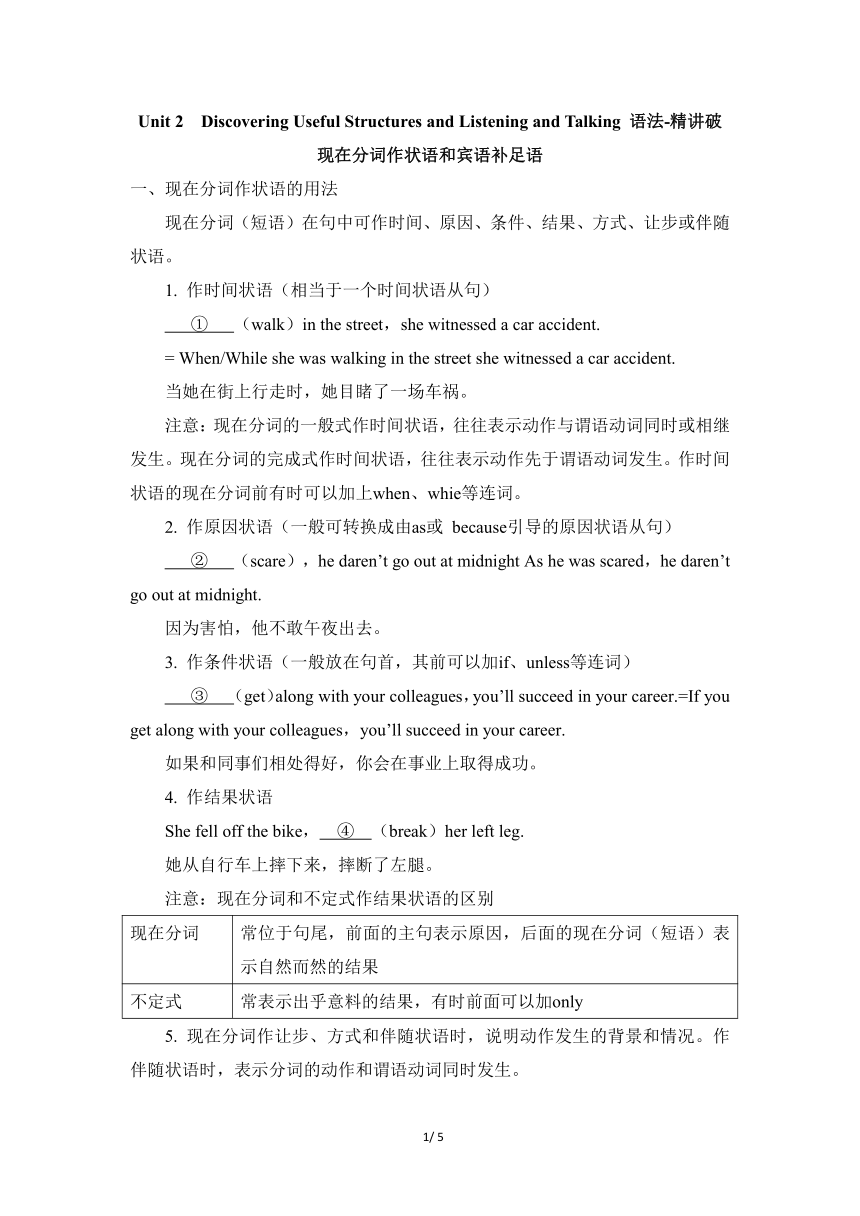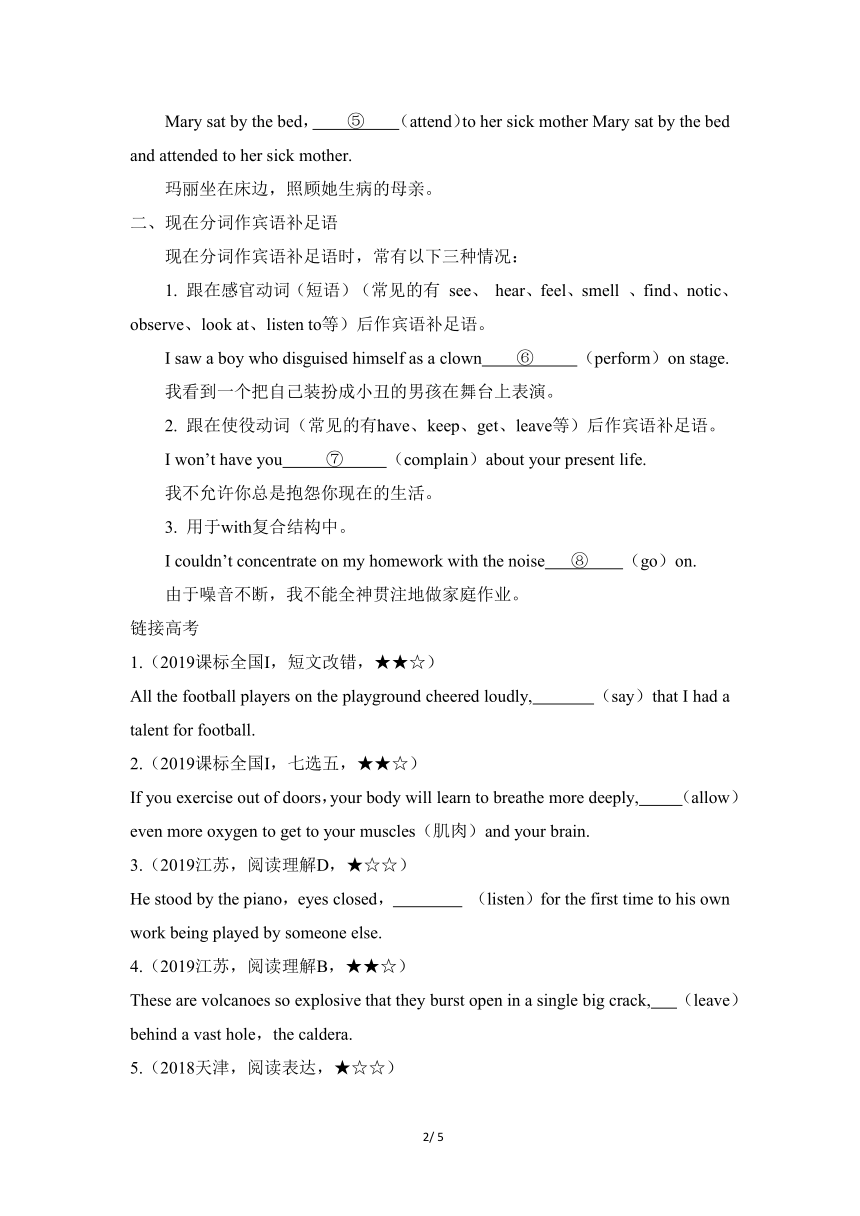人教版(2019)必修第三册 Unit2 Morals and Virtues Discovering Useful Structures and Listening and Talking_语法-精
文档属性
| 名称 | 人教版(2019)必修第三册 Unit2 Morals and Virtues Discovering Useful Structures and Listening and Talking_语法-精 |  | |
| 格式 | docx | ||
| 文件大小 | 21.4KB | ||
| 资源类型 | 教案 | ||
| 版本资源 | 人教版(2019) | ||
| 科目 | 英语 | ||
| 更新时间 | 2023-03-10 14:58:41 | ||
图片预览


文档简介
Unit 2 Discovering Useful Structures and Listening and Talking 语法-精讲破
现在分词作状语和宾语补足语
一、现在分词作状语的用法
现在分词(短语)在句中可作时间、原因、条件、结果、方式、让步或伴随状语。
1. 作时间状语(相当于一个时间状语从句)
① (walk)in the street,she witnessed a car accident.
= When/While she was walking in the street she witnessed a car accident.
当她在街上行走时,她目睹了一场车祸。
注意:现在分词的一般式作时间状语,往往表示动作与谓语动词同时或相继发生。现在分词的完成式作时间状语,往往表示动作先于谓语动词发生。作时间状语的现在分词前有时可以加上when、whie等连词。
2. 作原因状语(一般可转换成由as或 because引导的原因状语从句)
② (scare),he daren’t go out at midnight As he was scared,he daren’t go out at midnight.
因为害怕,他不敢午夜出去。
3. 作条件状语(一般放在句首,其前可以加if、unless等连词)
③ (get)along with your colleagues,you’ll succeed in your career.=If you get along with your colleagues,you’ll succeed in your career.
如果和同事们相处得好,你会在事业上取得成功。
4. 作结果状语
She fell off the bike, ④ (break)her left leg.
她从自行车上摔下来,摔断了左腿。
注意:现在分词和不定式作结果状语的区别
现在分词 常位于句尾,前面的主句表示原因,后面的现在分词(短语)表示自然而然的结果
不定式 常表示出乎意料的结果,有时前面可以加only
5. 现在分词作让步、方式和伴随状语时,说明动作发生的背景和情况。作伴随状语时,表示分词的动作和谓语动词同时发生。
Mary sat by the bed, ⑤ (attend)to her sick mother Mary sat by the bed and attended to her sick mother.
玛丽坐在床边,照顾她生病的母亲。
二、现在分词作宾语补足语
现在分词作宾语补足语时,常有以下三种情况:
1. 跟在感官动词(短语)(常见的有 see、 hear、feel、smell 、find、notic、observe、look at、listen to等)后作宾语补足语。
I saw a boy who disguised himself as a clown ⑥ (perform)on stage.
我看到一个把自己装扮成小丑的男孩在舞台上表演。
2. 跟在使役动词(常见的有have、keep、get、leave等)后作宾语补足语。
I won’t have you ⑦ (complain)about your present life.
我不允许你总是抱怨你现在的生活。
3. 用于with复合结构中。
I couldn’t concentrate on my homework with the noise ⑧ (go)on.
由于噪音不断,我不能全神贯注地做家庭作业。
链接高考
1.(2019课标全国I,短文改错,★★☆)
All the football players on the playground cheered loudly, (say)that I had a talent for football.
2.(2019课标全国I,七选五,★★☆)
If you exercise out of doors,your body will learn to breathe more deeply, (allow)even more oxygen to get to your muscles(肌肉)and your brain.
3.(2019江苏,阅读理解D,★☆☆)
He stood by the piano,eyes closed, (listen)for the first time to his own work being played by someone else.
4.(2019江苏,阅读理解B,★★☆)
These are volcanoes so explosive that they burst open in a single big crack, (leave)behind a vast hole,the caldera.
5.(2018天津,阅读表达,★☆☆)
Anxiously I went to bed (dream)about what I would find at the top of this magical mountain.
6.(2018课标全国Ⅲ,阅读理解B,★★★)
An avalanche(雪崩)once closed the path (kill)63 people.
7.(2018课标全国Ⅲ,短文改错,★★☆)
Everyone was silent, wait to see who would be called upon to read his or her paragraph aloud.
8.(2018课标全国Ⅱ,阅读理解A,★☆☆)
Thursday sees us make the short journey to Paris where we will visit Disneyland Paris park, (stay)until late to see the parade and the fireworks.
9.(2018江苏,26,★★☆)
Around 13,500 new jobs were created during the period (exceed)the expected number of 12, 000 held by market analysts.
10.(2018北京,阅读理解B,★★☆)
More than 750,000 have graduated from SAC, with many (seek)employment in engineering,aviation,education,medicine and a wide variety of other professions.
11.(2017天津,14,★★☆)
The hospital has recently obtained new medical equipment (allow)more patients to be treated.
12.(2016北京,32,★☆☆)
Newly-built wooden cottages line the street, (turn)the old town into a dreamland
13.(2015北京,23,★☆☆)The park was full of people, (enjoy)themselves in the sunshine.
参考答案:
① Walking② Being scared③ Getting④ breaking
⑤ attending⑥ performing(complaining③ going
1. saving 考查非谓语动词。句意:操场上的所有足球运动员都大声欢呼,说我有踢足球的天赋。All the football players和say之间是主动关系,应用现在分词作状语。故填saving。
2. allowing 考查非谓语动词。句意:如果你在户外锻炼,你的身体就会学会更深地呼吸,就会允许甚至更多的氧气到达你的肌肉和你的大脑。allowing even more oxygen为现在分词短语作结果状语。
3. listening 考查非谓语动词。句意:他站在钢琴旁,闭上眼睛,第一次听别人演奏自己的作品。设空处动作几乎与谓语动作同时发生,与主语构成主动关系。故用现在分词作伴随状语。
4. leaving 考查非谓语动词。该句中 leaving behind a vast hole表示火山爆发后造成的结果,提示词与主语构成主动关系。故用现在分词作结果状语。
5. dreaming 考查非谓语动词。提示词dream表示的动作伴随 went to bed发生,且与主语I构成主动关系,故用现在分词作状语。
6. killing 考查非谓语动词。Killing 63 people是结果状语,提示词与主语 An avalanche构成主动关系,故用现在分词。
7. waiting 考查非谓语动词。句意:每一个人都沉影不语,等着看谁将被叫到朗读他或她的段落Everyone和wait之间是主动关系,故应用现在分词形式。故填 waiting。
8. staving 考查非谓语动词。句意:周四我们去巴黎进行短途旅行,在那儿我们将游览巴黎迪土尼乐园,一直待到晚些时候观看游行和烟花。we和stay之间是主动关系,故用现在分词作状语。
9.exceeding考查非谓语动词。句意:在这段时间造了约13,500个新的工作岗位,超出了市场分析专家预测的12,000个。exceed与 Around 13,500new jobs之间为逻辑上的主动关系,所以要用现在分词
10. seeking 考查非谓语动词,句意:超过75万(人)已经毕业于SAC,许多人在工程,航空,教育,医学以及其他各种各样的行业中求职。seek与many之间是主动关系,故用现在分词作宾语补足语。
11. allowing 考查非谓语动词。句意:最近这家医院已经获得了新的医疗设备,使更多的病人得到治疗。“获得了新的医疗设备”和“使更多的病人得到治疗”之间是因果关系,且allow与其逻辑主语之间为主动关系,故用现在分词作结果状语。
12. turning 考查非谓语动词。句意:新建的木制小屋沿着大街排成一排,把旧城镇变成了梦镜。非谓语动词充当了结果状语,它的逻辑主语应是逗号前的整句话,两者之间为主动关系,故用现在分词turning
13. enjoying 考查非谓语动词。句意:公园里到处都是人,他们在阳光下玩得很愉快。people和enjoy是主动关系,故填现在分词enjoying。
现在分词作状语和宾语补足语
一、现在分词作状语的用法
现在分词(短语)在句中可作时间、原因、条件、结果、方式、让步或伴随状语。
1. 作时间状语(相当于一个时间状语从句)
① (walk)in the street,she witnessed a car accident.
= When/While she was walking in the street she witnessed a car accident.
当她在街上行走时,她目睹了一场车祸。
注意:现在分词的一般式作时间状语,往往表示动作与谓语动词同时或相继发生。现在分词的完成式作时间状语,往往表示动作先于谓语动词发生。作时间状语的现在分词前有时可以加上when、whie等连词。
2. 作原因状语(一般可转换成由as或 because引导的原因状语从句)
② (scare),he daren’t go out at midnight As he was scared,he daren’t go out at midnight.
因为害怕,他不敢午夜出去。
3. 作条件状语(一般放在句首,其前可以加if、unless等连词)
③ (get)along with your colleagues,you’ll succeed in your career.=If you get along with your colleagues,you’ll succeed in your career.
如果和同事们相处得好,你会在事业上取得成功。
4. 作结果状语
She fell off the bike, ④ (break)her left leg.
她从自行车上摔下来,摔断了左腿。
注意:现在分词和不定式作结果状语的区别
现在分词 常位于句尾,前面的主句表示原因,后面的现在分词(短语)表示自然而然的结果
不定式 常表示出乎意料的结果,有时前面可以加only
5. 现在分词作让步、方式和伴随状语时,说明动作发生的背景和情况。作伴随状语时,表示分词的动作和谓语动词同时发生。
Mary sat by the bed, ⑤ (attend)to her sick mother Mary sat by the bed and attended to her sick mother.
玛丽坐在床边,照顾她生病的母亲。
二、现在分词作宾语补足语
现在分词作宾语补足语时,常有以下三种情况:
1. 跟在感官动词(短语)(常见的有 see、 hear、feel、smell 、find、notic、observe、look at、listen to等)后作宾语补足语。
I saw a boy who disguised himself as a clown ⑥ (perform)on stage.
我看到一个把自己装扮成小丑的男孩在舞台上表演。
2. 跟在使役动词(常见的有have、keep、get、leave等)后作宾语补足语。
I won’t have you ⑦ (complain)about your present life.
我不允许你总是抱怨你现在的生活。
3. 用于with复合结构中。
I couldn’t concentrate on my homework with the noise ⑧ (go)on.
由于噪音不断,我不能全神贯注地做家庭作业。
链接高考
1.(2019课标全国I,短文改错,★★☆)
All the football players on the playground cheered loudly, (say)that I had a talent for football.
2.(2019课标全国I,七选五,★★☆)
If you exercise out of doors,your body will learn to breathe more deeply, (allow)even more oxygen to get to your muscles(肌肉)and your brain.
3.(2019江苏,阅读理解D,★☆☆)
He stood by the piano,eyes closed, (listen)for the first time to his own work being played by someone else.
4.(2019江苏,阅读理解B,★★☆)
These are volcanoes so explosive that they burst open in a single big crack, (leave)behind a vast hole,the caldera.
5.(2018天津,阅读表达,★☆☆)
Anxiously I went to bed (dream)about what I would find at the top of this magical mountain.
6.(2018课标全国Ⅲ,阅读理解B,★★★)
An avalanche(雪崩)once closed the path (kill)63 people.
7.(2018课标全国Ⅲ,短文改错,★★☆)
Everyone was silent, wait to see who would be called upon to read his or her paragraph aloud.
8.(2018课标全国Ⅱ,阅读理解A,★☆☆)
Thursday sees us make the short journey to Paris where we will visit Disneyland Paris park, (stay)until late to see the parade and the fireworks.
9.(2018江苏,26,★★☆)
Around 13,500 new jobs were created during the period (exceed)the expected number of 12, 000 held by market analysts.
10.(2018北京,阅读理解B,★★☆)
More than 750,000 have graduated from SAC, with many (seek)employment in engineering,aviation,education,medicine and a wide variety of other professions.
11.(2017天津,14,★★☆)
The hospital has recently obtained new medical equipment (allow)more patients to be treated.
12.(2016北京,32,★☆☆)
Newly-built wooden cottages line the street, (turn)the old town into a dreamland
13.(2015北京,23,★☆☆)The park was full of people, (enjoy)themselves in the sunshine.
参考答案:
① Walking② Being scared③ Getting④ breaking
⑤ attending⑥ performing(complaining③ going
1. saving 考查非谓语动词。句意:操场上的所有足球运动员都大声欢呼,说我有踢足球的天赋。All the football players和say之间是主动关系,应用现在分词作状语。故填saving。
2. allowing 考查非谓语动词。句意:如果你在户外锻炼,你的身体就会学会更深地呼吸,就会允许甚至更多的氧气到达你的肌肉和你的大脑。allowing even more oxygen为现在分词短语作结果状语。
3. listening 考查非谓语动词。句意:他站在钢琴旁,闭上眼睛,第一次听别人演奏自己的作品。设空处动作几乎与谓语动作同时发生,与主语构成主动关系。故用现在分词作伴随状语。
4. leaving 考查非谓语动词。该句中 leaving behind a vast hole表示火山爆发后造成的结果,提示词与主语构成主动关系。故用现在分词作结果状语。
5. dreaming 考查非谓语动词。提示词dream表示的动作伴随 went to bed发生,且与主语I构成主动关系,故用现在分词作状语。
6. killing 考查非谓语动词。Killing 63 people是结果状语,提示词与主语 An avalanche构成主动关系,故用现在分词。
7. waiting 考查非谓语动词。句意:每一个人都沉影不语,等着看谁将被叫到朗读他或她的段落Everyone和wait之间是主动关系,故应用现在分词形式。故填 waiting。
8. staving 考查非谓语动词。句意:周四我们去巴黎进行短途旅行,在那儿我们将游览巴黎迪土尼乐园,一直待到晚些时候观看游行和烟花。we和stay之间是主动关系,故用现在分词作状语。
9.exceeding考查非谓语动词。句意:在这段时间造了约13,500个新的工作岗位,超出了市场分析专家预测的12,000个。exceed与 Around 13,500new jobs之间为逻辑上的主动关系,所以要用现在分词
10. seeking 考查非谓语动词,句意:超过75万(人)已经毕业于SAC,许多人在工程,航空,教育,医学以及其他各种各样的行业中求职。seek与many之间是主动关系,故用现在分词作宾语补足语。
11. allowing 考查非谓语动词。句意:最近这家医院已经获得了新的医疗设备,使更多的病人得到治疗。“获得了新的医疗设备”和“使更多的病人得到治疗”之间是因果关系,且allow与其逻辑主语之间为主动关系,故用现在分词作结果状语。
12. turning 考查非谓语动词。句意:新建的木制小屋沿着大街排成一排,把旧城镇变成了梦镜。非谓语动词充当了结果状语,它的逻辑主语应是逗号前的整句话,两者之间为主动关系,故用现在分词turning
13. enjoying 考查非谓语动词。句意:公园里到处都是人,他们在阳光下玩得很愉快。people和enjoy是主动关系,故填现在分词enjoying。
